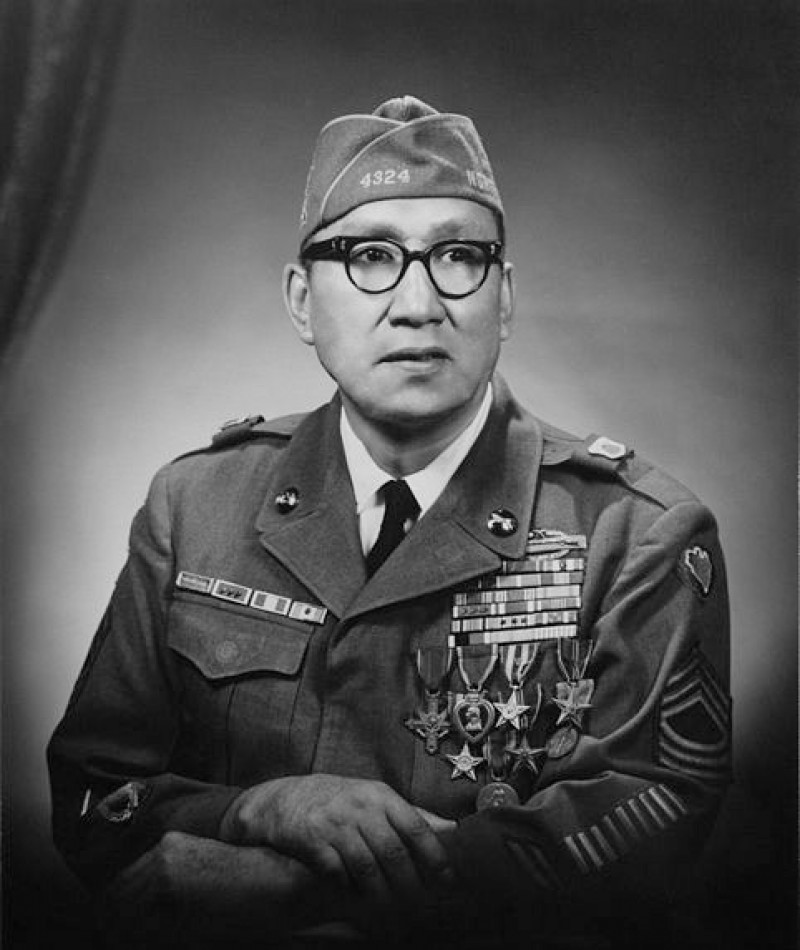
Korean War
-
MoH
Wahpeton, ND
Circumstances:
Master Sergeant Keeble saw that the attacking elements had become pinned down on the slope by heavy enemy fire from three well-fortified and strategically placed enemy positions. With complete disregard for his personal safety, Master Sergeant Keeble dashed forward and joined the pinned-down platoon. Then, hugging the ground, Master Sergeant Keeble crawled forward alone until he was in close proximity to one of the hostile machine-gun emplacements. Ignoring the heavy fire that the crew trained on him, Master Sergeant Keeble activated a grenade and threw it with great accuracy, successfully destroying the position. Continuing his one-man assault, he moved to the second enemy position and destroyed it with another grenade. Despite the fact that the enemy troops were now directing their firepower against him and unleashing a shower of grenades in a frantic attempt to stop his advance, he moved forward against the third hostile emplacement and skillfully neutralized the remaining enemy position.
Biography:
Master Sergeant Woodrow W. Keeble distinguished himself by acts of gallantry and intrepidity at the risk of his life above and beyond the call of duty in action with an armed enemy near Sangsan-ni, Korea on 20 October 1951.
On that day, Master Sergeant Keeble was an acting platoon leader for the support platoon in Company G, 19th Infantry, in the attack on Hill 765, a steep and rugged position that was well defended by the enemy. Leading the support platoon, Master Sergeant Keeble saw that the attacking elements had become pinned down on the slope by heavy enemy fire from three well-fortified and strategically placed enemy positions. With complete disregard for his personal safety, Master Sergeant Keeble dashed forward and joined the pinned-down platoon. Then, hugging the ground, Master Sergeant Keeble crawled forward alone until he was in close proximity to one of the hostile machine-gun emplacements. Ignoring the heavy fire that the crew trained on him, Master Sergeant Keeble activated a grenade and threw it with great accuracy, successfully destroying the position. Continuing his one-man assault, he moved to the second enemy position and destroyed it with another grenade. Despite the fact that the enemy troops were now directing their firepower against him and unleashing a shower of grenades in a frantic attempt to stop his advance, he moved forward against the third hostile emplacement and skillfully neutralized the remaining enemy position.
As his comrades moved forward to join him, Mater Sergeant Keeble continued to direct accurate fire against nearby trenches, inflicting heavy casualties on the enemy. Inspired by his courage, Company G successfully moved forward and seized its important objective.
The extraordinary courage, selfless service, and devotion to duty displayed that day by Master Sergeant Keeble was an inspiration to all around him and reflected great credit upon himself, his unit and the United States Army. Biography: An athletic man in his youth, Master Sergeant Keeble was being recruited by the Chicago White Sox when he was called to duty in WWII.
Upon returning to North Dakota after the war, Master Sergeant Keeble taught at the Wahpeton Indian School, which he himself had attended after his mother passed away when he was a child. Master Sergeant Keeble was again called to service during the Korean War, where he notably volunteered as an individual augmentee from the 164th Infantry Regiment to deploy to Korea. When Master Sergeant Keeble returned from the Korean War, he resumed teaching at the Wahpeton Indian School.
Unfortunately, soon after his return he was diagnosed with tuberculosis, which required the removal of one of his lungs. The surgery triggered a series of strokes leaving Master Sergeant speechless and partially paralyzed. Several months later his wife of 14 years, Nettie, passed away, leaving him to care for their young son Earl.
In 1967, Master Sergeant Keeble married Blossom Iris Crawford-Hawkins, the first Sioux woman to complete a PhD program, including doctoral dissertation at the University of South Dakota. In 1982, Master Sergeant Keeble passed away.
His valor on the battlefield was legendary. Friends, family and four U.S. Senators in North and South Dakota continued their pursuit for the Medal of Honor even after his death.
His strength, size and prowess as a warrior led fellow Soldier James Fenelon, a member of the Standing Rock Sioux tribe who fought with Master Sergeant Keeble at Guadalcanal, to say, "The safest place to be was right next to Woody." Master Sergeant Keeble's bravery in combat, leading Soldiers, is beyond question. Of his call to duty, Master Sergeant Keeble said, "There were terrible moments that encompassed a lifetime, an endlessness, when terror was so strong in me, that I could feel idiocy replace reason. (Yet,) I have never left my position, nor have I shirked hazardous duty. Fear did not make a coward out of me."
Master Sergeant Keeble volunteered for duty when members of the 164th Infantry Regiment were called to fight in the Korean War. When asked why, he replied, "Somebody has to teach these kids how to fight."
For actions in combat, Master Sergeant Keeble received the Distinguished Service Cross, the Silver Star, the Bronze Star, two Purple Hearts and the Combat Infantryman Badge.
Units of Service: North Dakota National Guard's 164th Infantry Regiment and G Co., 2nd Bn., 19th Inf. Reg, 24th ID
